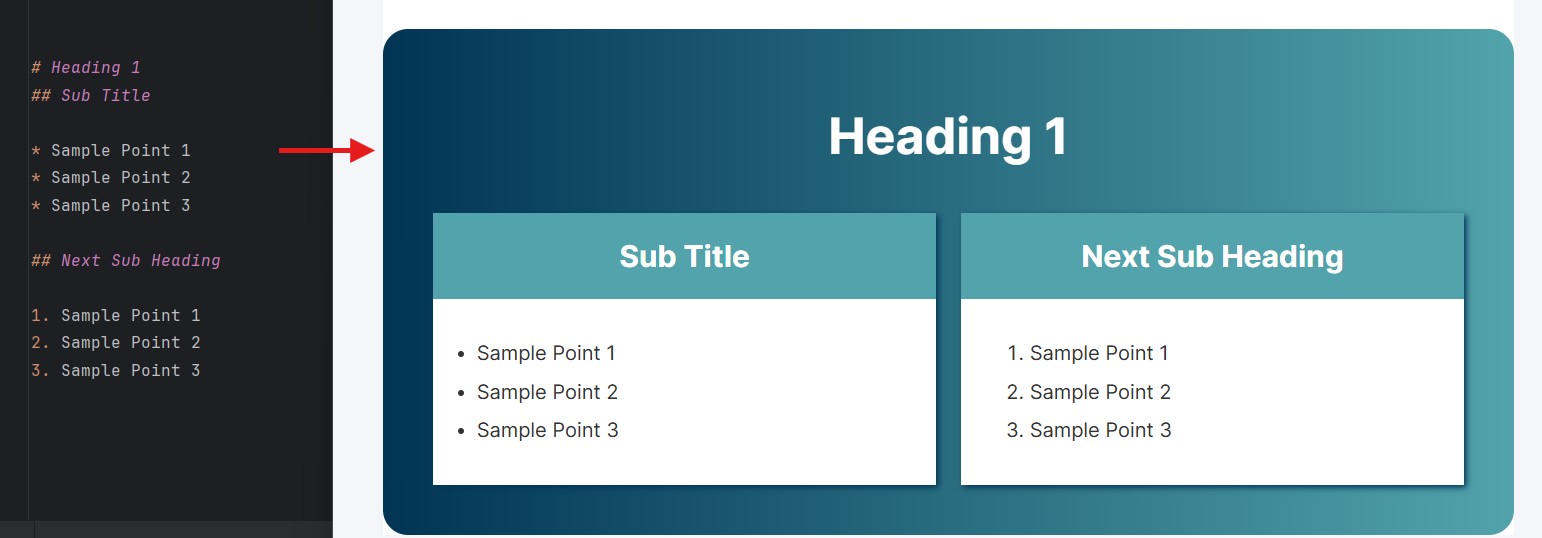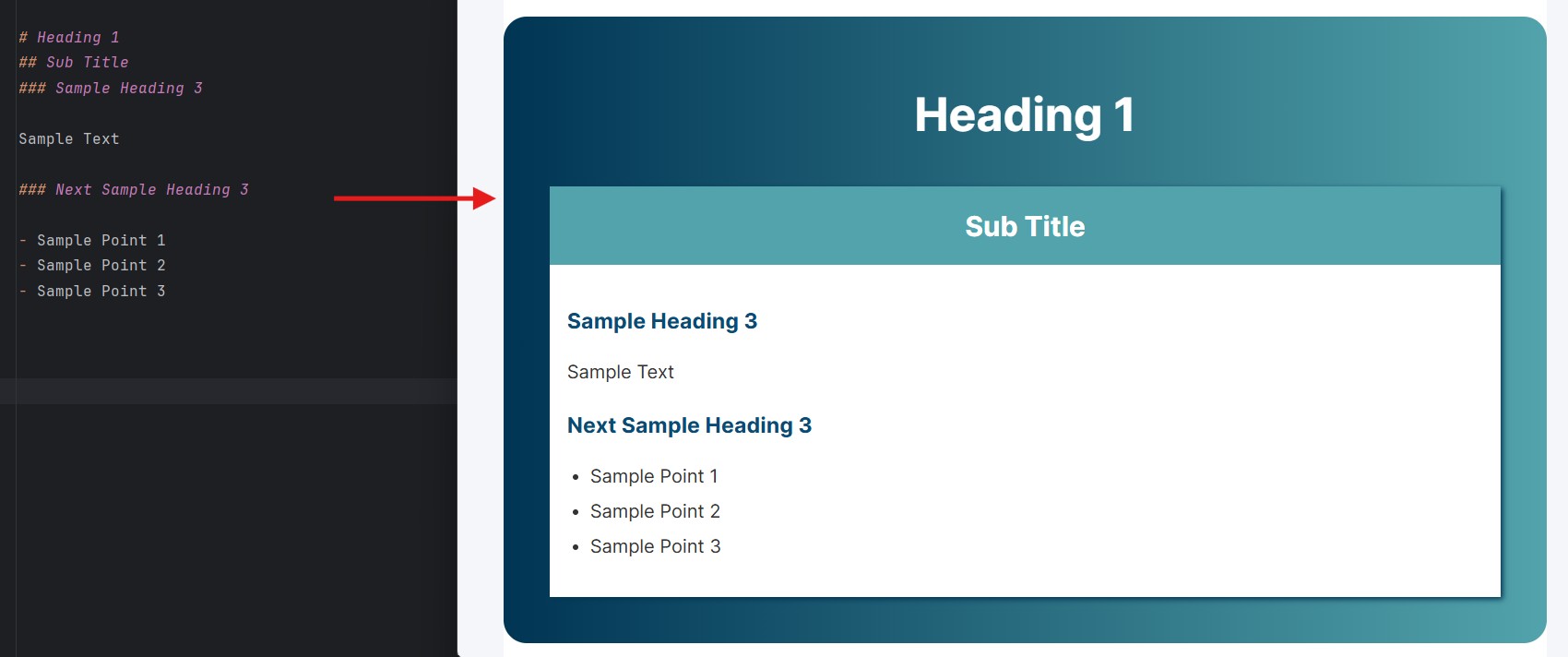md2indexhtml is a powerful Python package that converts Markdown files to beautifully styled HTML pages specifically designed for Odoo modules. It uses comprehensive Odoo frontend styling classes from web.assets_frontend.min.css to create professional, responsive documentation that integrates seamlessly with Odoo's design system.
Create stunning, professional HTML documentation from Markdown with authentic Odoo styling
Simple command, beautiful results:
md2indexhtml README.md- Comprehensive Odoo Styling: Uses authentic Odoo frontend classes for consistent design
- Dictionary-Based Configuration: Flexible styling system using JSON configuration files
- Semantic HTML5: Generates clean, accessible HTML with proper semantic structure
- Automatic Image Handling: Processes and copies images with responsive styling
- Custom Style Configurations: Override default styling with custom JSON configurations
- CLI Integration: Simple command-line interface with powerful options
- Responsive Design: Mobile-friendly layouts with Odoo's responsive classes
- Typography Excellence: Beautiful typography using Odoo's font system
- Card-Based Layouts: Automatic section organization into elegant card layouts
- Table Enhancement: Professional table styling with striped rows and hover effects
Install the package using pip:
pip install md2indexhtmlConvert your README.md to Odoo-styled HTML:
cd your_odoo_module
md2indexhtml README.mdThis creates a beautifully styled static/description/index.html file perfect for the Odoo Apps Store.
If you have a markdown file in your current directory:
md2indexhtmlIt automatically finds and converts the first .md file found.
Specify where to save the HTML file:
md2indexhtml README.md --output /path/to/docs.html
# or use the short form
md2indexhtml README.md -o /path/to/docs.htmlSet a custom title for your HTML document:
md2indexhtml README.md --title "Module Documentation"Create a JSON file with your custom styling preferences:
{
"h1": {
"class": "display-2 text-primary text-center mb-5",
"style": "border-bottom: 3px solid #875A7B;"
},
"p": {
"class": "lead text-muted mb-4"
},
"table": {
"class": "table table-dark table-striped table-hover"
}
}Then apply it:
md2indexhtml README.md --style-config my-styles.jsonSee all available styling options:
md2indexhtml --show-configThis displays the complete default Odoo styling configuration organized by categories.
The package comes with comprehensive default styling that covers:
- Typography: Headers (h1-h6), paragraphs, emphasis, code blocks
- Lists: Unordered, ordered, and definition lists
- Tables: Full table styling with headers, borders, and hover effects
- Forms: Input fields, buttons, fieldsets with Odoo styling
- Layout: Containers, sections, cards, and grid systems
- Media: Images, figures, and responsive media elements
- Navigation: Navigation bars, breadcrumbs, and links
- Interactive: Alerts, badges, progress bars, and tooltips
Style configurations use a simple dictionary format:
{
"element_name": {
"attribute_name": "attribute_value",
"class": "css-classes",
"id": "element-id",
"style": "inline-css"
}
}Examples:
{
"h2": {
"class": "text-center text-primary mb-4",
"style": "border-bottom: 2px solid #875A7B;"
},
"blockquote": {
"class": "alert alert-info border-left-primary",
"style": "border-left: 4px solid #17a2b8;"
},
"img": {
"class": "img-fluid rounded shadow-lg mb-4 d-block mx-auto",
"style": "max-height: 400px;"
}
}The default configuration includes styling for:
- Typography Elements: h1-h6, p, strong, em, small, mark
- List Elements: ul, ol, li, dl, dt, dd
- Table Elements: table, thead, tbody, tr, th, td
- Code Elements: pre, code
- Media Elements: img, figure, figcaption
- Layout Elements: div, section, article, main, aside, header, footer
- Form Elements: form, input, textarea, select, button, fieldset, legend
- Interactive Elements: a, nav, details, summary
The package intelligently converts markdown elements:
# Headersbecome full-width sections with Odoo styling## Subheadersbecome card-based feature sections- Lists are styled with Odoo's list classes
- Code blocks get syntax highlighting and proper spacing
- Images are automatically made responsive and centered
- Tables receive full Odoo table styling
You can mix HTML directly in your markdown:
# My Module
<section class="py-5 bg-primary text-white text-center">
<h2>Custom HTML Section</h2>
<p>This will be preserved exactly as written</p>
</section>
## Features
- Feature 1
- Feature 2
<div class="alert alert-warning">
<strong>Note:</strong> Important information here
</div>The package automatically processes images:
# Using Markdown

# Using HTML
<img src="assets/demo.jpg" alt="Demo" />Automatic Processing:
- Copies images to
images/directory in output location - Updates paths to use only filenames (flattens directory structure)
- Adds responsive classes automatically
- Preserves external URLs and base64 images
- Warns about missing images but continues processing
Use the package programmatically:
from md2indexhtml import convert_md_to_html
# Basic conversion
convert_md_to_html("README.md")
# With custom configuration
style_config = {
"h1": {"class": "display-1 text-center text-primary"},
"p": {"class": "lead mb-4"}
}
convert_md_to_html(
md_file_path="README.md",
title="My Documentation",
output_path="docs/index.html",
style_config=style_config
)
# Load configuration from file
from md2indexhtml.converter import create_style_config_from_file
config = create_style_config_from_file("styles.json")
convert_md_to_html("README.md", style_config=config)The generated HTML includes:
- Semantic Structure: Proper HTML5 semantic elements
- Responsive Design: Mobile-first responsive layout
- Odoo Integration: Native Odoo styling classes
- Typography: Professional typography with Odoo fonts
- Accessibility: ARIA labels and semantic markup
- Performance: Optimized CSS and clean HTML structure
Files generated with md2indexhtml are specifically designed for the Odoo Apps Store:
- Uses
oe_structurecontainers for proper Odoo integration - Includes proper meta tags and viewport settings
- Follows Odoo's design guidelines and color schemes
- Optimized for the Apps Store's rendering system
# Convert with defaults
md2indexhtml README.md
# Custom title and output
md2indexhtml README.md --title "My Module" --output custom.html
# Apply custom styling
md2indexhtml README.md --style-config custom-styles.json
# View default configuration
md2indexhtml --show-config
# Get version
md2indexhtml --version# Inventory Management Pro
Advanced inventory management for Odoo with real-time tracking.
## Key Features
- Real-time stock tracking
- Automated reorder points
- Advanced reporting dashboard
- Mobile-friendly interface
## Installation
1. Download the module
2. Install in your Odoo instance
3. Configure your settings
## Screenshots

Create custom-style.json:
{
"h1": {
"class": "display-3 text-center text-primary mb-5",
"style": "text-shadow: 2px 2px 4px rgba(0,0,0,0.1);"
},
"h2": {
"class": "h3 text-secondary mb-3 border-bottom border-primary pb-2"
},
"img": {
"class": "img-fluid rounded-lg shadow-lg mb-4 d-block mx-auto",
"style": "border: 3px solid #875A7B;"
}
}Apply it:
md2indexhtml README.md --style-config custom-style.jsonContributions are welcome! Please feel free to submit pull requests or open issues on GitHub.
git clone https://github.com/fasilwdr/md2indexhtml.git
cd md2indexhtml
pip install -e .This project is licensed under the MIT License. See the LICENSE file for details.
Fasil (@fasilwdr)
Email: [email protected]
GitHub: https://github.com/fasilwdr
Transform your Markdown documentation into professional, Odoo-ready HTML with md2indexhtml!


